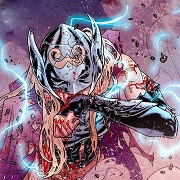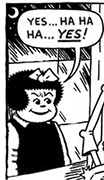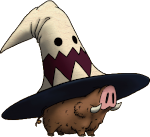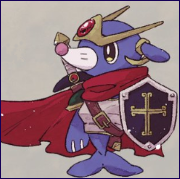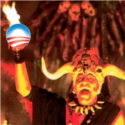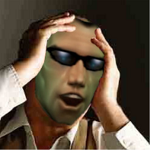|
Leperflesh posted:I'm waiting eagerly for the future where there's a 4e retroclone movement and we get dozens of super-derivative attempts at recapturing the nostalgic "atmosphere" of 4th edition. Somebody get me a Markov chain and the complete text of 4e.
|
|
|
|

|
| # ? May 9, 2024 09:05 |
|
Kwyndig posted:Somebody get me a Markov chain and the complete text of 4e. Hey, don't steal my drunk Denny's idea from a month ago.
|
|
|
|
Serf posted:"No spells, you are the terrible game mechanics." And then Animate Dead was cast.
|
|
|
|
unseenlibrarian posted:The worst is when this attitude infects other games: I had a GM for a Mutants and Masterminds game once that wouldn't let my Hawkeye-inspired archery dude take a perception ranged attack (Meaning no attack roll, it just did damage) with a justification of "He's just that accurate when he wants to be" because his powers were training-based, but admitted that if my concept had been "Arrow wizard" it'd have been just fine.
|
|
|
|
Leperflesh posted:I'm waiting eagerly for the future where there's a 4e retroclone movement and we get dozens of super-derivative attempts at recapturing the nostalgic "atmosphere" of 4th edition. It turns out that there were a half-dozen types of gamer that were turned on by 4E so games like Strike! totally scratch the itch for the storygamish DTAS crowd but completely misses the people who were enamored by a "fixed d20" or who enjoyed the highly-customizable tactical miniatures game that 4E also was. Plus there's this focus on "fixing" it and forcing their game design conceits which completely invalidates the nostalgia aspect. An actual retroclone would just forward-engineer all of third edition's mechanics so it's open source and compatible with your favorite fantasy roleplaying system. The irony of it being based on Pathfinder might destroy the universe (or at least the greater Seattle area). I keep tossing around the idea of doing just that.
|
|
|
|
Halloween Jack posted:D&D 3 design sense is "the rules are a physics engine" and half the rules are spells. You can't make a working non-spellcaster based on the assumption that everything that works consistently is a spell. It's pretty telling that the Fixed Fighter already exists--it's in Tome of Battle and D&D 4. But those aren't acceptable, because they get powers with defined effects. (I have to admit, Frank Trollman did a Fixed Fighter that is much better than most of the others I've seen.) I've actually played a complete campaign with Frank's classes. It was fun, but the entire game engine comes unzipped above level 13-14, but that happens anyway so not sure that's a mark against them. The fighter/samurai/barbarian can do stuff effectively through level 13-14 though and they 'feel' OK at the table but yeah it becomes unplayable in combat. Zurui posted:It turns out that there were a half-dozen types of gamer that were turned on by 4E so games like Strike! totally scratch the itch for the storygamish DTAS crowd but completely misses the people who were enamored by a "fixed d20" or who enjoyed the highly-customizable tactical miniatures game that 4E also was. I'd love a custom CBloader file or whatever that was just someone deleting all the trash feats from the game so you could really go to down on the tactical miniatures game.
|
|
|
|
Leperflesh posted:I'm waiting eagerly for the future where there's a 4e retroclone movement and we get dozens of super-derivative attempts at recapturing the nostalgic "atmosphere" of 4th edition. The problem with retrocloning 4E is it would take a lot more actual work than copy-pasting the entirety of OD&D, adding a couple houserules, and putting your name on the cover. I'm not just being glib either, making an RPG in the vein of 4E is a lot of work. It's legitimately impressive when you look back at 4E and see how they managed to make all those classes with all those abilities out to 30 levels and somehow the game never completely fell apart (though it certainly had its flaws), then you look at Next and the lack of effort is palpable. And it's going to be the same thing with third party stuff. Like, Strike! is maybe the best completed "here's my game drawing heavily on 4E" I've seen and it wasn't like Jimbozig whipped it out in a weekend. Most folks don't have the time or inclination (or skill) to put in the effort to make a 4E clone that has the robust level of crunch that 4E had, it's a lot easier to churn out another lovely low-effort OSR retroclone and call it a day.
|
|
|
|
In the early days of 4e I (like a lot of people) thought I'd whip up a martial controller class, and I discovered first-hand how drat difficult it is to build a good 4e class. There was a lot wrong with 4e's mechanics at release, but the class design was always spot-on. I've still got a yen to create a game based on 4e, drawing heavily on the tactical combat element (my favourite bit) but designing a bunch of classes is always the part where I grind to a halt.
|
|
|
|
The trouble with designing a class in 4e is that you have to design a SHITTON of stuff and it ALL has to be balanced and cool. I mean, there are ten more levels than any other edition, and about half of them need two or three powers designed. I started to write a class once and got no further than about level 5. It's a lot of work. It does make me wonder whether post-Essentials there was so much neutered design just because it was easier and they'd had so many budget and staffing cuts by that stage that they just couldn't *do* difficult any more.
|
|
|
|
I think that's why they put such a high emphasis on "reskinning". Between your choice of role, your choice of power source, your choice of powers (including those which are more thematic than optimal), and your choice of what those powers diegetically mean, it should be possible to represent and depict drat near anything without having to get into the mechanical nitty-gritty, which is the part that's hard. EDIT: A 4e campaign where you have to prefix all of your powers with a Star Wars reference. Sith Eldritch Blast. Imperial Commander's Strike. Jedi Come and Get It.
|
|
|
|
gradenko_2000 posted:EDIT: A 4e campaign where you have to prefix all of your powers with a Star Wars reference. Sith Eldritch Blast. Imperial Commander's Strike. Jedi Come and Get It. Come and Get IT-IT
|
|
|
|
thespaceinvader posted:It does make me wonder whether post-Essentials there was so much neutered design just because it was easier and they'd had so many budget and staffing cuts by that stage that they just couldn't *do* difficult any more. This is probably it more than any nefarious conspiracy theory about 4E being thrown under the bus. The prolific output of 3E and 4E are basically the product of a period where WotC layoffs hadn't slashed their talent pool down to the bone, 4E very clearly ran out of steam near the end even though they still managed to put out some good stuff in the form of the Monster Vault, Heroes of the Feywild, etc. I mean, I also don't think Mike Mearls is a very good Head of D&D, but even if he was they just don't have the manpower to do something like 4E 2.0 anymore.
|
|
|
|
I get the feeling it was a bit of both - Mearls didn't like 4e's design so he didn't make the effort, AND they couldn't afford the talent to make the effort in his place. THe most effort went on HotFeywild and even that only got I think two complete classes and some races (which are of course a shitton easier to design). It wasn't a nefarious conspiracy, it was just that there was a lack of enthusiasm, and even from around Essentials I have the feeling that 5e was in the works. The lead time even for a team of WotC's competence on a project like that is huge. So it's partly that no-one cared, and partly that the few who cared a bit had at best a split focus.
|
|
|
|
Halloween Jack posted:I've never actually met anyone who played a lovely ineffective fighter and loved it, but if these people you met never read real fantasy in favour of D&D franchise novels, that might explain it. Also for as much as it gets dismissed, rightfully so, there are certainly gaming groups whose gamemasters mitigate wizardly advantages by forcing the party into situations where multiple combats in sequence, or at least virtually no downtime to rest and regain spells, are fairly commonplace during actual adventuring. Going into a fight with a full host of spells in 2nd, 3rd, 3.5th, or Pathfinder (I have not really gamed in years obviously) was always particularly uncommon, so the fighters could shine on a regular basis. But yeah, a game where the standard routine is fight/rest/fight/rest, I can see how fighters would be less fun to play through the mere existence of wizards. Asimo posted:"And the characters understand the game mechanics!" is one of those things that sounds novel, except it's been done literally decades beforehand already and really doesn't work all that fun in play since instead of metagaming you wind up with metametagaming and it's sort of recursive and horrible. Look, if that does not sound fun to you, I JUST DO NOT KNOW WHAT TO SAY Also does anyone actually go to Origins because apparently I am going now? Have we ever had a thread for Origins
|
|
|
|
I think the main difference between old D&D and 3e, 3.5 & 5 on caster supremacy is the introduction of concentration checks. When the casters spell was fritzed on any interruption with no chance to save it, it made for a game where even if they overpowered the rest of the team, at least the rest of the team were necessary in the fight. It also helped that fighter with all rules in play were death incarnate in early D&D. Thieves still sucked though. 4E really did do it best.
|
|
|
|
The main thing is, wizards lost almost all their disadvantages and hold backs in 3e, and fighters lost almost everything good and unique they had. The 2e Fighter even without weapon mastery can suddenly introduce an absurd amount of damage to an enemy (and was hilarious with weapon mastery), was mobile in ways wizards and clerics weren't, AC was exceptionally valuable, and while they started off with the worst saving throws, they improved faster then any other class and were second best soon enough. This isn't even touching the whole "Leadership" thing. Then 3e comes in. The fighter loses it's mobility as the game introduces it's different types of actions (suddenly making all your attacks is a "full round action," so no movement). Spellcasters immediately steal that mobility, as spellcasting goes from a full round thing to only a simple action. As each attack is at a lower bonus then the others, and weapons themselves do less damage, the fighter loses a lot of his damage. Weapon Mastery is nerfed into pointlessness. Monster HP skyrockets, so fighters aren't just doing less damage, they're doing it against bigger monsters. Attack bonuses likewise skyrocket, so AC becomes way more pointless; a 2e fighter could laugh at enemies unable to hit him as his armor made him invincible, but now that wasn't going to happen. Saving throws are radically altered to ensure everyone always has at least one "weak" save - and fighters are given two. Wizards are given ways to increase their save-or-whatever spells, so now wizards have a plethora of one-hit kill spells. Clerics gain access to a ton of new tricks and spells, so now they're better at being fighters then the fighters are. 3.x's skill system is introduced, and fighters are put at the very bottom. Casters can now resist having their spells interrupted - which means fighters can no longer interrupt them with ease. The fighter wasn't the only one to suffer this. Lots of classes saw their unique abilities taken away and given to spellcasters. Rangers lost their animal companion - and druids took it from them. Paladins lost their circle of protection and some of the coolest powers they got while using a holy blade while the change in how weapons worked and new spells meant priests were actually better at combat then the paladins were. The change in making multiple attacks destroyed one of the main things warriors got over other classes. And so on, and so forth. Everything strong or unique that the non-casters got, they lost. Most of it reappeared in spellcaster hands, but now even more powerful. 3.x was openly a "gently caress you, jocks" edition. It's telling that, all of a sudden, every scary monster in 3e is a spellcaster. Nobody gave a gently caress about dragons using their claws or wings or firey breath, it was scary because dragons were also wizards. Balors stopped using their flaming whips and terrible vorpal blades, and became wizards. Etc, etc.
|
|
|
|
Adding to what you just said (though you touched on it), if I remember right, magic resistance in 2e was static (not to mention saves). Want to kill an archfiend? Better bring a fighter, because your spells will probably bounce off.
|
|
|
Halloween Jack posted:Adding to what you just said (though you touched on it), if I remember right, magic resistance in 2e was static (not to mention saves). Want to kill an archfiend? Better bring a fighter, because your spells will probably bounce off. It was not quite as good as all that, sadly. Lower Magic Resistance and Nap together were MORE than enough to ensure that casters remained supreme in most all cases. It got so bad that people were publishing monsters with over a hundred percent magic resistance, because Lower MR rolled against half their value.
|
|
|
|
|
Where the heck was nap published, anyway? I remember a GM digging it out of a deck of spell cards or something for one game, and never seeing it again. That spell was absurd.
|
|
|
|
Bieeardo posted:Where the heck was nap published, anyway? I remember a GM digging it out of a deck of spell cards or something for one game, and never seeing it again. That spell was absurd. MATTHEW from the GIANT IN THE PLAYGROUND FORUMS in 2007 posted:Tome of Magic:
|
|
|
|
Dr. Quarex posted:Where can you find a scrap of pillow ticking in this day and age I think the bigger concern is where a wizard would get pillow ticking in the pseudo medieval setting assumed by your standard D&D game. Edit: because seriously in a modern setting you could buy it by the truckload thanks to manufacturing.
|
|
|
|
ProfessorCirno posted:Everything strong or unique that the non-casters got, they lost. Most of it reappeared in spellcaster hands, but now even more powerful. 3.x was openly a "gently caress you, jocks" edition. It's telling that, all of a sudden, every scary monster in 3e is a spellcaster. Nobody gave a gently caress about dragons using their claws or wings or firey breath, it was scary because dragons were also wizards. Balors stopped using their flaming whips and terrible vorpal blades, and became wizards. Etc, etc. Has there ever been an explanation for why 3e ended up that way? What culture shift happened that made everyone want to play a game where magic-users could do everything and martials could do jack poo poo?
|
|
|
|
Harrow posted:Has there ever been an explanation for why 3e ended up that way? What culture shift happened that made everyone want to play a game where magic-users could do everything and martials could do jack poo poo? It was their first game and when your first game has 5000 splats, it's the Only Game. Monty Cook was beat up constantly by jocks, but never by wizards.
|
|
|
|
Harrow posted:Has there ever been an explanation for why 3e ended up that way? What culture shift happened that made everyone want to play a game where magic-users could do everything and martials could do jack poo poo? I wouldn't say everyone, it's just it was the new edition of D&D. It's hard to explain the zeitgeist to someone who wasn't active in the scene at the time.
|
|
|
|
Harrow posted:Has there ever been an explanation for why 3e ended up that way? What culture shift happened that made everyone want to play a game where magic-users could do everything and martials could do jack poo poo? I don't think it was intentional, I get the impression they just wanted to make wizards less fiddly and bump up clerics to make them more popular (to ensure groups having a healer), while conversely assuming as long as fighters had the most consistent, good DPR they were filling their role. I highly doubt they intended to make full spellcasters dominant, but it's where the design unintentionally led.
|
|
|
|
By all accounts 3E was not rigorously playtested, like, at all. It was playtested but it was done so in an extremely casual "we're just going to treat this like it's AD&D2E with a new coat of paint" mode...Wizards used blaster spells, Druids didn't exploit shapeshifting and summoning much, Clerics stayed in the back and healed all the time, etc. Let's be honest, there aren't too many people around here who wouldn't get rid of a lot of the fiddly bullshit that was ostensibly supposed to keep spellcasters in check in prior editions, like rigorously tracking material components, having to safeguard your spellbook, randomly assigned spells with random chances to learn new ones, insta-fizzle if you take so much as a hitpoint of damage, etc. All of that stuff is tedious and, in a lot of folks' opinions, unfun and so hey, let's get rid of all that. The problem is they didn't bother to consider the ramifications of any of this, or any of their other decisions (like what happens when average monster HP goes up but the damage of spells like Fireball remain unchanged from the prior edition). They had huge blinders on the entire time and this led to them creating a game full of unintended results. I'm sure that some part of it was also the same sadly common bias a lot of elfgame designers have towards favoring people with special powers over the mundane baseline guys who have to play by a rigid set of rules, but I think a much bigger part of it was simply shoddy and absent stress-testing. Someone looking to break 3E straight out of the core rulebook could do so trivially, so the only explanation for why nobody caught it is that nobody thought to do so, which is a failure to properly playtest in every sense that matters.
|
|
|
|
That explanation makes sense. A bunch of design decisions made thinking that people would play it like 2e, combined with not considering how those worked with the new mechanics and math assumptions, would reasonably lead to how 3.x ended up. I'm a little surprised it got its hooks into the hobby so deeply, but I guess that was just when a lot of nerds in their late 20s/early 30s (like me) got started, huh? Golden Bee posted:It was their first game and when your first game has 5000 splats, it's the Only Game. Kwyndig posted:I wouldn't say everyone, it's just it was the new edition of D&D. It's hard to explain the zeitgeist to someone who wasn't active in the scene at the time. Yeah, I phrased that poorly. I guess I meant, why did the designers think people wanted that? The D&D 3e books were my first D&D books. I got them long before I ever played D&D but they still colored what I thought roleplaying was supposed to be for a good, long time. I can't imagine how much stronger that feeling would be if I'd bought piles of splats and played tons of 3.x and was really invested.
|
|
|
|
Kai Tave posted:By all accounts 3E was not rigorously playtested, like, at all. It was playtested but it was done so in an extremely casual "we're just going to treat this like it's AD&D2E with a new coat of paint" mode...Wizards used blaster spells, Druids didn't exploit shapeshifting and summoning much, Clerics stayed in the back and healed all the time, etc. Most people I talk to still play the game like this. I don't know if it's self-imposed "if I use Glitterdust and Sleep to trivialize everything no one will have me at the table" or if people just actually don't think to do that (or they just want to blow poo poo up), but it's quite rare for me to talk to anyone who genuinely thinks Pathfinder/3.5e-style casters are actually more broken than, say, Monks.
|
|
|
|
Yeah it's like Kai Tave said, it was a combination of inadequate playtesting and pressure from the higher ups at Wizards to release a new edition because the old edition had poo poo the bed so hard there was nowhere to go but up as far as sales were concerned. Seriously, the only reason TSR was up for sale was because they were hemorrhaging money from years of bad licensing deals and a terrible glut of products nobody wanted.
|
|
|
|
Dr. Quarex posted:Where can you find a scrap of pillow ticking in this day and age Tome of Magic, that explains. That book was absurdly difficult to find in this neck of the woods, for some reason. In a lot of ways, on the surface, 3E reflected an entire raft of house rules that we'd cooked up over the years. Multi-classing was easier, clerics were better melee combatants, and spontaneous casting was an (ahem) godsend. Add to that a few rules that made wizards not lose hard if they got dinged in combat, a much more interesting looking skill system, and an easy way to add class levels to monsters, and it looked about perfect once we got past our groggy glasses. Of course, we never really took a close look at the math. Or the skill system. Or challenge rating calculations. The group's GM had always taken a dim view of one shot kill effects (he was always in it for the math) so we didn't really run into that as an issue, but he simply adored the expanding array of metamagic feats.
|
|
|
|
Halloween Jack posted:Adding to what you just said (though you touched on it), if I remember right, magic resistance in 2e was static (not to mention saves). Want to kill an archfiend? Better bring a fighter, because your spells will probably bounce off. This was actually only the case in 2e; in 1e, it would vary based on caster level. quote:Magic Resistance - The percentage chance of any spell absolutely failing in the monsterís presence. It is based on the spell being cast by an 11th level magic-user, and must be adjusted upwards by 5% for each level the caster is below 11th or downwards by 5% for each level the caster is above 11th. Thus a magic resistance of 95% means that a 10th level magic-user has no possibility of affecting the monster with a spell, while a 12th level MU has a 10% chance. Even if a spell does take effect on a magic-resistant creature, the creature is then entitled to normal saving throws. But the rule in question only appeared at the start of the MM and the glossary at the tail end of the DMG. The intensely obscure nature of 1e's presentation of its rules meant that a lot of people missed it - including, apparently, the designers of 2e.
|
|
|
|
Harrow posted:That explanation makes sense. A bunch of design decisions made thinking that people would play it like 2e, combined with not considering how those worked with the new mechanics and math assumptions, would reasonably lead to how 3.x ended up. Possibly the ages are even younger, but yes, this is a big part of it. It's hard to overstate how big 3E D&D was. I mean, we're still talking about the TRPG hobby and not like a new Call of Duty, but the release of 3E was kind of a big loving deal and it was honestly a lot of peoples' introduction to D&D proper after years of D&D slowly sliding into irrelevancy and financial oblivion due to bad business decisions and a waning pop culture star. Suddenly WotC, the guys behind Magic which, even if it wasn't as big as it is nowadays was still kind of a big deal itself, owns D&D!? And they're making a new edition!? Wizards can take feats to learn how to use swords!? Every race can be whatever class they want!? Holy poo poo! And this was also the days of big chain bookstores so you could go and buy D&D if not in the toy stores of old then at least at the mall, and so yeah, a lot of people got into the hobby courtesy of 3E and first impressions are strong ones. This is why a lot of the stuff 3E did gets enshrined as tradition even if prior editions did it differently, because a lot of the people enshrining it don't actually care about the older stuff...that's not where they started developing strong opinions about elfgames. Countblanc posted:Most people I talk to still play the game like this. I don't know if it's self-imposed "if I use Glitterdust and Sleep to trivialize everything no one will have me at the table" or if people just actually don't think to do that (or they just want to blow poo poo up), but it's quite rare for me to talk to anyone who genuinely thinks Pathfinder/3.5e-style casters are actually more broken than, say, Monks. It's a little of column A, a little of column B. Some folks just don't give a poo poo and will never read a treatise on charop or class tiers and it'll never occur to them to do stuff like that the same way, to borrow another example from Overwatch, it won't occur to most people to try a coordinated 4 D.Va push on Hanamura attack backed by a Lucio and a Reinhardt even though you can completely stomp the other team by rocket-boosting four chunky mechs onto the first point, then speed-capping the second. They know how the game is "supposed" to work, so they simply don't consider alternatives. Meanwhile some of it is probably gentlemen's agreement stuff the same way that 40K players try and cultivate gentlemen's agreements, because the moment someone doesn't and decides "gently caress it, I'm going full CoDzilla" and the game goes off the rails then they have to confront the fact that yep, the rules are hosed, and they don't want to do that because some folks don't like to acknowledge that the game they've devoted themselves to is janky and broken (see also, Star Trek Attack Wing).
|
|
|
|
Kai Tave posted:Possibly the ages are even younger, but yes, this is a big part of it. It's hard to overstate how big 3E D&D was. I mean, we're still talking about the TRPG hobby and not like a new Call of Duty, but the release of 3E was kind of a big loving deal and it was honestly a lot of peoples' introduction to D&D proper after years of D&D slowly sliding into irrelevancy and financial oblivion due to bad business decisions and a waning pop culture star. Suddenly WotC, the guys behind Magic which, even if it wasn't as big as it is nowadays was still kind of a big deal itself, owns D&D!? And they're making a new edition!? Wizards can take feats to learn how to use swords!? Every race can be whatever class they want!? Holy poo poo! And this was also the days of big chain bookstores so you could go and buy D&D if not in the toy stores of old then at least at the mall, and so yeah, a lot of people got into the hobby courtesy of 3E and first impressions are strong ones. This is why a lot of the stuff 3E did gets enshrined as tradition even if prior editions did it differently, because a lot of the people enshrining it don't actually care about the older stuff...that's not where they started developing strong opinions about elfgames. Yeah, 3E was huge. I'd played AD&D before but 3E really kicked everything off. And honestly, it was pretty good compared to the stuff around it at as well. What else was kicking around? You had the vampire stuff, GURPS, champions, paranoia. I feel like the competition wasn't nearly as strong as well. 3E had a big push from WoTC, big distribution and wasn't a terrible game.
|
|
|
|
There's a passage from the 3rd Edition Rules Compendium that I thought was insightful:quote:EVOLUTION OF SPELL RESISTANCE And then you've also got things like: 1. The crit confirmation system as an evolution of how the Combat & Tactics crit system worked. Now the chance to crit would vary per weapon instead of always being nat 18-20. Now the increased damage on crit would vary instead of always being x2. Now you only needed to "hit again" rather than having to exceed the target-roll-to-hit by 3 (but you'd have to roll twice). 2. The Sorcerer as a counter-reaction to the AD&D Wizard's inflexibility of Vancian spell slots and completely-DM-controlled spell acquisition: trade the ability to learn every spell, for the ability to cast spells from slots interchangeably and the incontrovertible ability to know a specific sub-set of any spells. 3. The Wizard themselves gaining the ability to learn any two spells on level-up, again to counteract completely-DM-controlled spell acquisition, on top of the aforementioned slackening of all the fiddly Wizard rules. 4. The feat system as a rationalization and formalization of the acquisition of Combat & Tactics abilities and High-Level Campaigns abilities (and a whole bunch of other abilities). 5. Conversion to an ascending AC system, as well as formalizing the idea of Touch AC and Flat-Footed AC as things that Gygax was writing about by at least as early as AD&D, except you didn't track them as separate rules concepts The impression I'm getting is that 3rd Edition was a good-faith attempt to deliver a product that was an improvement, an iteration and an evolution of AD&D 2e's concepts, in much the same way that a lot of 4th Edition's design was an evolution of what worked and what didn't with 3rd Edition. It's just that, as was mentioned, all that stuff was never really quite playtested or rigorously math-plotted out, so it kinda all fell apart even from the beginning where the Wizard getting two spells per level already invalidates much of the Sorcerer's raison d'etre even before you've begun play, or feats having so many different goals and objectives hung onto them that it couldn't possibly support everything, combined with a dash of Monte Cook's "Ivory Tower" design and it becomes a mess. But I think they honestly tried to make a good game. Combine this with the fact that 3rd Edition was released at a time when most late-twentysomethings and early-thirtysomethings of today would have been in their teens and therefore would have been their first D&D, plus the fact that 3rd Edition's release was hailed as a triumphant return of a game that people honestly thought would go away forever with the shuttering of TSR, and the fact that all of this "AD&D, but we fixed it" went over much better because AD&D died a "natural death" rather than WOTC forcing 4th Edition down your throat while also bagging on 3rd Edition's "bad design" all throughout 4th's marketing campaign, and quite a number of people received 3rd Edition with open arms, and then also look back upon 3rd Edition favorably.
|
|
|
|
Countblanc posted:Most people I talk to still play the game like this. I don't know if it's self-imposed "if I use Glitterdust and Sleep to trivialize everything no one will have me at the table" or if people just actually don't think to do that (or they just want to blow poo poo up), but it's quite rare for me to talk to anyone who genuinely thinks Pathfinder/3.5e-style casters are actually more broken than, say, Monks. That's the group I play with.
|
|
|
|
Dr. Quarex posted:Also does anyone actually go to Origins because apparently I am going now? If I see a thread I'll sticky it for Origins 
|
|
|
|
Origins is apparently a big enough deal that Evil Hat has said not going would be a financial loss for them in the Fate More kickstarter stuff, so I'm guessing some people go, anyway.
|
|
|
|
One thing very important to note - and probably the reason D&D has not and likely will not ever hit the vague cultural relevancy amongst nerds it hit with 3e - is that it was timed, maybe on accident, impeccably. For starters, it came on the heels of a MASSIVE cRPG revival. cRPGs were in a sharp decline more or less the same time AD&D 2e was. The big mainstays weren't really around anymore;. Gold Box games had stopped their yearly releases, Ultima was in a slump after the garbage that was Pagan, Daggerfall spent two years in limbo and had been pronounced vapourware (and when it DID come out it was a buggy mess), Betrayal at Kronder looked like poo poo and was pretty complex if you didn't know what you were already doing. The industry had half-shoved itself up it's own rear end, and half lost itself in advancements in PC technology. All the while consoles were completely stealing their lunch with the huge popularity of JRPGs which were way more character and dialogue focused with tons of inter-party relationships and drama (or at least the best drama you could do on a Super Nintendo post-translation) and RTS and FPS games were starting their own big sorta golden ages. Then out of loving nowhere comes Diablo to remind everyone that computers can have RPGs too, and goes ahead and invents the action RPG genre while it's at it. Fantasy is suddenly kinda cool again! You can even play it online, with other people! So that's rad, and also really new, at least for it's scope. This essentially opens things up for Interplay to make it's own big step in with Fallout and, a year later, Baldur's Gate. I legitimately do not think it would've been the big hit it was if you didn't have a lot of outside stuff coming into play, and the revival of cRPGs and similar played a massive part in this. Third edition was released in August 2000. Baldur's Gate 2 was one month later. Diablo 2 was one month before (technically June, but the very end of June). Again: fantasy was cool again. And more then just that, nerds had poo poo to care about again. Of course, the other major thing is that 3rd edition was more or less the internet edition. 4e was the post-internet edition, which might explain a lot there, but 3e was when all the nerds, not just the older ones on usenet, but even the younger ones like loving my dumb rear end, were connecting. Maybe it was early SomethingAwful, maybe it was on vague open ended roleplay forums, maybe it was lovely EZBoards, it was easy for nerds to spread excitement. And there was a ton to be excited about! Like I said, you had all these new and rad computer RPGs; you had all these rad console RPGs, you had anime, just tons and tons of poo poo to talk about. And 3e walks in and goes hey, fantasy's real cool right? You all like being creative and making lovely fanfic and making dumb OCs? Guess who's all about that poo poo? This guy. So yeah, I really don't think 3e's popularity was due to it's mechanical merits. It came out at the best possible time a game COULD come out at. It was a series of circumstances that I frankly don't see repeating.
|
|
|
Kai Tave posted:By all accounts 3E was not rigorously playtested, like, at all. It was playtested but it was done so in an extremely casual "we're just going to treat this like it's AD&D2E with a new coat of paint" mode...Wizards used blaster spells, Druids didn't exploit shapeshifting and summoning much, Clerics stayed in the back and healed all the time, etc. Let's be honest, there aren't too many people around here who wouldn't get rid of a lot of the fiddly bullshit that was ostensibly supposed to keep spellcasters in check in prior editions, like rigorously tracking material components, having to safeguard your spellbook, randomly assigned spells with random chances to learn new ones, insta-fizzle if you take so much as a hitpoint of damage, etc. All of that stuff is tedious and, in a lot of folks' opinions, unfun and so hey, let's get rid of all that. I was a 3e playtester, and this is almost entirely true. Playtesting was strongly focused on problems the players saw in 2e, and in 2e, the big thing was damage spells and stuff like Stoneskin. Worse, like 95% of the playtesting corps was drawn from Living City, and in Living City, everybody had simply accepted that caster supremacy was the way things were and should be. The campaign was something like 45% wizards, 45% clerics, 9% other casters, and 1% noncasters. If you were playing a fighter or thief, people would just ask you when you intended to dual class, not if you were going to. It was a given, because no matter what people like to say about fighters having a niche in 2e, it simply wasn't true in practice, especially once splats started coming into it. Edit: Also, if you think casters were bad as printed, you should see some of the poo poo we kept from getting to print. NinjaDebugger fucked around with this message at 12:04 on Jun 6, 2016 |
|
|
|
|

|
| # ? May 9, 2024 09:05 |
|
ProfessorCirno posted:One thing very important to note - and probably the reason D&D has not and likely will not ever hit the vague cultural relevancy amongst nerds it hit with 3e - is that it was timed, maybe on accident, impeccably. For starters, it came on the heels of a MASSIVE cRPG revival. This, with the addition that the hype for the Lord of the Rings movies was huge. Massive, even. Those played a role in getting people interested in D&D again too, probably more than the cRPG revival.
|
|
|






